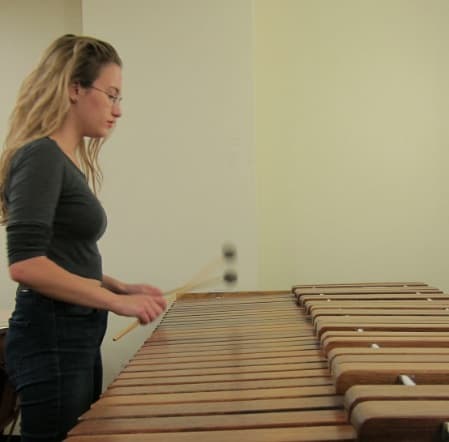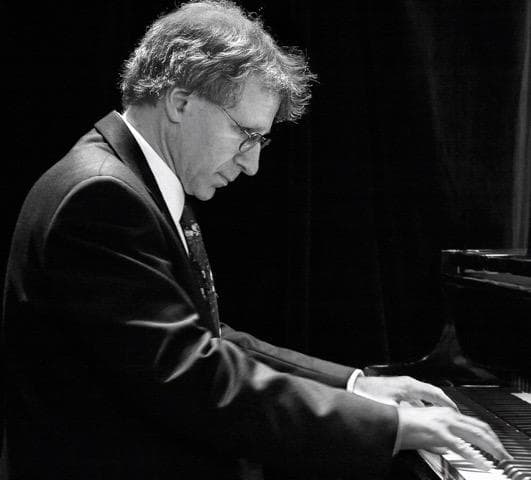Advertisement
Play Through The Pain? Audition Season Means Injury Risk For Young Musicians
Caitlin Cawley was only 15 when she developed tendinitis in both elbows. The condition is commonly known as "tennis elbow," but Cawley wasn't practicing her serve. She was studying classical percussion at a pre-college program for aspiring musicians.
She ignored the early signs until the prickling sensation grew to stabbing pain throughout her forearms so excruciating she had to stop playing. It took three months of rest for the inflammation in her tendons to subside, and she has had multiple flareups since then.
Now 21 and a senior at Boston University’s School of Music, Cawley is preparing to audition for graduate programs. So while most college applicants can breathe a sigh of relief now that their Jan. 1 deadline has passed, she and other music students are headed back to the practice rooms. Cawley currently averages six hours of independent practice a day, not including ensemble rehearsals. In her words: “Right now I’m doing as much work as I’ve ever done for music.”

That diligence also means risk of injury. For Cawley and other young musicians, the question of this season is: How much practice can my body take before perfection turns to pain?
Their odds are not good. In the mid-2000s, a Chicago-based physician began surveying the incoming music students at a midwestern university, and after four years, the trend in the data was clear: Almost 80 percent of freshman “reported a history of playing-related pain.”
For players of string, keyboard and brass instruments the percentage was even higher. For percussionists like Cawley: 100 percent.
Dr. Michael Charness, who directs the Performing Arts Clinic at Brigham and Women’s Hospital, has treated thousands of musicians who play everything from bagpipes and sitars to violas and trombones.
He describes the crux of the problem: “If you look at a string quartet, it’s the most natural looking sight, but if you simply remove the instruments from their hands and pose them on stage, it’s nothing that we were ever really designed to do for any long period of time.”
How much practice can my body take before perfection turns to pain?
The arms are elevated, wrist extended, head tilted -- all while performing rapid repetitive motions (a two-minute movement from Handel’s "Messiah" includes 740 strokes of the violin bow). It’s a recipe for repetitive stress injuries, and the same could be said of any instrument when played intensively.
High-pressure events such as auditions and recitals bring heightened risk, Charness says; they push musicians to put in eight or 10 hours a day and repeat the same passage over and over to get it right — "things that most athletes know not to do." He often sees those same musicians in his clinic once the pressure has passed.
Performing Patients
Every Saturday, there is a line of musicians at the Brigham and Women’s clinic carrying instrument cases of all shapes and sizes. Dan Snydacker, a harpsichordist who travels from Connecticut for treatment, describes the waiting area as tense — somber even: “We all share this sense of potential loss.”
About half of the musicians that Charness sees suffer from overuse injuries to the soft tissue, such as tendinitis. The doctor watches each one play, looking for tension in the shoulders or an unnecessary twist in the wrist — subtle habits that can lead to strain.
Slightly less common are nerve injuries — often in the wrist and elbow, where nerves can become compressed or entrapped in the joints. In many cases the condition is totally painless, only affecting the musician’s coordination.
The most rare and debilitating musical malady is focal dystonia, a neurological condition that is rooted in the brain but impacts a specific part of the body — fingers for pianists and sometimes the lips for players of wind instruments. The condition is not well understood even though it affects almost 2 percent of professional musicians — including the celebrated pianist Leon Fleisher and possibly the 19th century composer Robert Schumann.
Advertisement
Snydacker, the harpsichordist, knew something was wrong when he started missing notes on the keyboard. Then he noticed that his fingers were curling under his palm involuntarily when he tried to play. The dystonia was interfering with the motor routines he had developed over years of playing, and he now receives regular botox injections that relax the overactive muscles in his hand. Total recovery is unlikely; Snydacker is just hoping that he can still play the harpsichord for his grandchildren.

Charness is a keyboard player himself, and he started treating musicians after suffering his own injury — an entrapped nerve in his elbow. He was a medical resident at the time, but none of his neurology professors could explain what was wrong. His hands seemed perfectly fine, but on the piano keyboard they had suddenly lost their precision.
Once Charness did find treatment, other musicians he knew suddenly started “coming out of their closets” and approaching him about their own injuries. This was in the mid-1980s, and there was no clinic for performing artists, so Charness saw them in a back room of the lab where he worked. Within two years, he says, he was treating principal orchestra players from around the country, including almost one-quarter of the local San Francisco Symphony — all by word of mouth, all in secret.
The stigma and secrecy surrounding injury make perfect sense from the musicians’ standpoint: Orchestras don’t want injured players any more than a baseball team does. Even musicians with steady employment might keep health issues secret from their colleagues and conductor, afraid of facing additional scrutiny. So Charness is careful to guard the confidentiality of his patients, knowing that this secrecy makes it even harder for them to get help.
Practicing Wellness
A lot has changed in performing arts medicine since Charness first ran his back-room medical practice. The issue gained widespread attention in 1987 when a study by the International Conference of Symphony and Orchestra Musicians found that 76 percent of their members had experienced a playing injury that seriously affected their performance.
Charness opened his clinic in Boston two years later, and it is now one of several in the country that specifically treat musicians.
But in the classical music world, old habits die hard. Music camps still ask kids to play for seven hours a day and many teachers are more attuned to expression and tone than they are to mechanics and posture.
The stigma of injury persists as well. Cawley recalls hearing at age 16: “If you tell people that you're injured, you won't work, people won't hire you.” And while none of her teachers today would ever tell her to “play through the pain,” the competitive culture of the music industry pushes some musicians to do just that.
Cawley must navigate this contradictory terrain carefully. During a recent practice session, she was working on a Bach cello suite arranged for marimba, an instrument whose tuned wooden bars are laid out like the keys on a piano, extending nine feet from end to end. The notes came in a constant stream and Cawley, just over five feet tall, stayed on the balls of her feet as she moved to follow the melody.
"Like everyone of my generation I practiced until I couldn't practice any more. I practiced too much."
Harpsichordist Dan Snydacker
“The thing about Bach,” she says, “you can’t miss.” If the mallet falls an inch to the left, everyone will know. But as determined as she was to get the notes right, she was equally determined not to push her body too hard. Another injury now could upend everything that she was practicing for.
Cawley’s first graduate school audition is just a few weeks away, but she knows her limits and won’t push them. Every practice session starts with 30 minutes of stretching and warm-ups and she won’t go more than 90 minutes without taking a break. If she can’t work more with her hands, Cawley will practice by studying the scores — a technique she developed after her first bout of tendinitis when she couldn’t play more than 15 minutes a day.
Most of these practice strategies were not taught in conservatories when Snydacker studied music in the 1970s. He recalls: “Like everyone of my generation I practiced until I couldn't practice any more. I practiced too much.” He played through the tension and through the discomfort — things musicians today know not to do. Charness has worked over his career to spread this knowledge, and gives tips for injury prevention on the clinic’s website.
But even with all the best practices and caution in the world, the fear of injury remains.
Cawley has seen the surgical scars on the arms of her peers who suffered from nerve entrapment, and heard the stories of opportunities lost or careers ended by health problems. As she took a break from practicing, Cawley reflected on the tenuous nature of her chosen profession: “It's hard to think that your body is so connected to your livelihood. Most people, when their body gets injured in some way, can still feed their family. If you're an orchestra player, you only have one skill in this world. And if that goes away, you're kind of screwed. It's a weird thing to have to contend with.”
As soon as we finished talking, it was back to practicing. Auditions are approaching, the day was getting on, and she was still shy of her six-hour target.
Ian Coss is a Ph.D. student in ethnomusicology at Boston University who has done music reporting for The World and Afropop Worldwide. He writes at iancoss.com